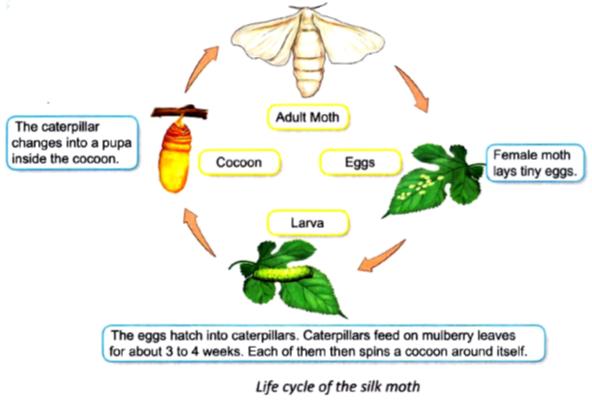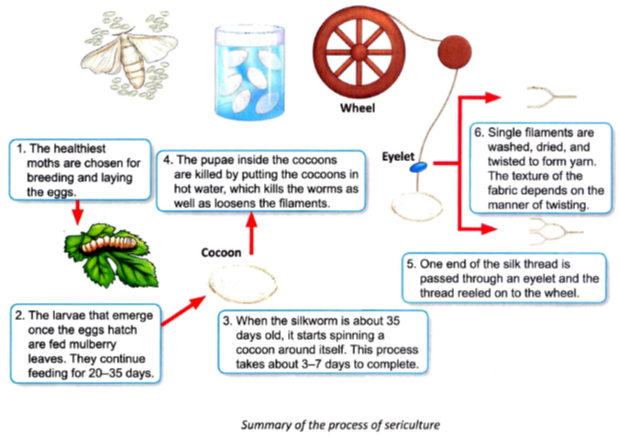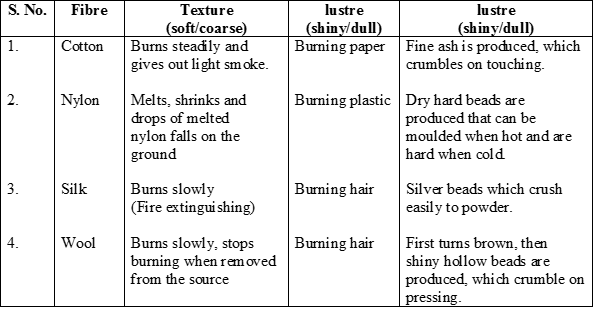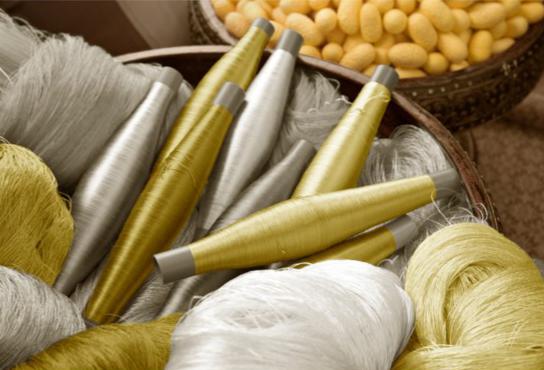- Books Name
- CBSE Class 7 Science Book
- Publication
- Param Publication
- Course
- CBSE Class 7
- Subject
- Science
(ii) Silk :
Silk is an animal fibre derived from silkworms. Silk is produced by a moth (species) known as silk moth. The scientific name of silk moth is “Bombyx mori”.
The breeding of these silk moths for production of silk is known as “sericulture”.
(a) Production of Silk :
The female species of silk moth lays eggs on leaves. After 20 days, eggs hatch into larvae. these hatched larvae are known as Silkworms or Caterpillars.
(i) The silkworms are fed on mulberry leaves for about 6 weeks. As a result, they grow in size and enter their next life cycle called Pupa. Pupa holds itself by weaving a net around its body by swinging its head in figure of eight (8). While swinging their head, silkworm secretes a wet sticky substance. This substance is made up of protein, which hardens on exposure to air and becomes silk fibre. This way silkworm covers itself completely in the covering known as Cocoon. By the time of completion, cocoon pupa, develops into Adult Moth.
(ii) After complete development of silkworm, the cocoons are gathered and kept under the sun or boiled or exposed to steam, Boiling releases the silk fibres from cocoon. The silk fibres from many cocoons are brought together to form a single silken thread. This process is known as Reeling of silk. Reeling is done in special machines which unwind the fibres of silk from the cocoons.
(iii) Broadly, 3 grades of silk is obtained from a cocoon. The unwound fibres form the finest quality silk called the reeled silk. It is dazzling white in colour. Silk that remains after the reeling process from the damaged or waste cocoon is carded and combed. It constitutes an inferior quality of silk called the spun silk. It is slightly honey-coloured. After carding or combing, the short fibres which are left behind constitute an even inferior quality of silk called the Nail Silk. It has rough texture as compared to reeled and spun silk.
(iv) Throwing is the process by which the obtained silk fibres are twisted into a strand for weaving to prevent silk yarn from splitting into individual fibres. These strands are industry ready to be turned into clothes.

(b) Summary of sericulture

Remember
• Silk is considered the queen of fibres. It is used for making dress materials, saris, scarves, jackets, gloves and carpets.
• Silk fibre is mainly made of two proteins : sericine and fibroin
• Pheromones : These are chemical secreted by an insect to attract the attention of other members of its species.
(c) Varieties of Silk
• The damaged or waste cocoons are used to produce an inferior quality of silk called spun silk.
• Crepe is a kind of silk thread made by twisting individual threads of raw silk, then doubling two or more of these together and twisting them again.
• Tram is the type of silk thread made by twisting two or more silk threads together in only one direction.
• Thrown singles is the type of silk, in which individual threads are twisted in only one direction.
• Organizing is the type of silk thread made by twisting a thread in one direction bringing two or more such threads together and twisting them in the opposite direction.
• mulberry silk is produced by Bombyx mori worms. These worms are fed on the leaves of mulberry trees.
• Eri Silk is produced by Philosomia ricin worms. These worms are fed on leaves of oaster trees leaves.
• Tusser silk and Muga silk are produced by Anheraea Mylitta worms.
Remember
• Semi-synthetic fibres :
These are obtained from naturally occurring fibres by chemical modifications. For example, cellulose on reaction with acetic anhydride in the presence of concentrated sulphuric acid gives cellulose diacetate, which is used for making threads of acetate and other materials like films and glasses.
• Synthetic (artificial) fibres :
Synthetic fibres are manufactured by man in the laboratories. For example: nylon, acrylic and polyester.
1.4 Burning characteristics of various fibres

Silk
Silk is one of the most delicate, popular, strong, soft, shiny, and expensive fibres obtained from silkworms. The rearing of silkworms for obtaining silk is called sericulture. The steps in the life cycle of a silkworm are Egg → Silkworm → Pupa → Adult Moth. When a female moth lays eggs, its life cycle starts, and larvae secrete a fine filament made of fibroin protein that forms cocoons.


 Param Publication
Param Publication
 Grow Career Publication
Grow Career Publication
